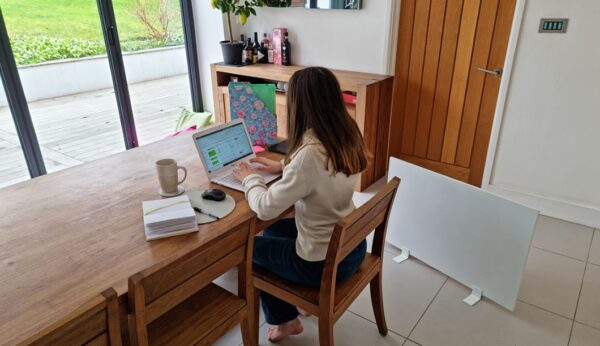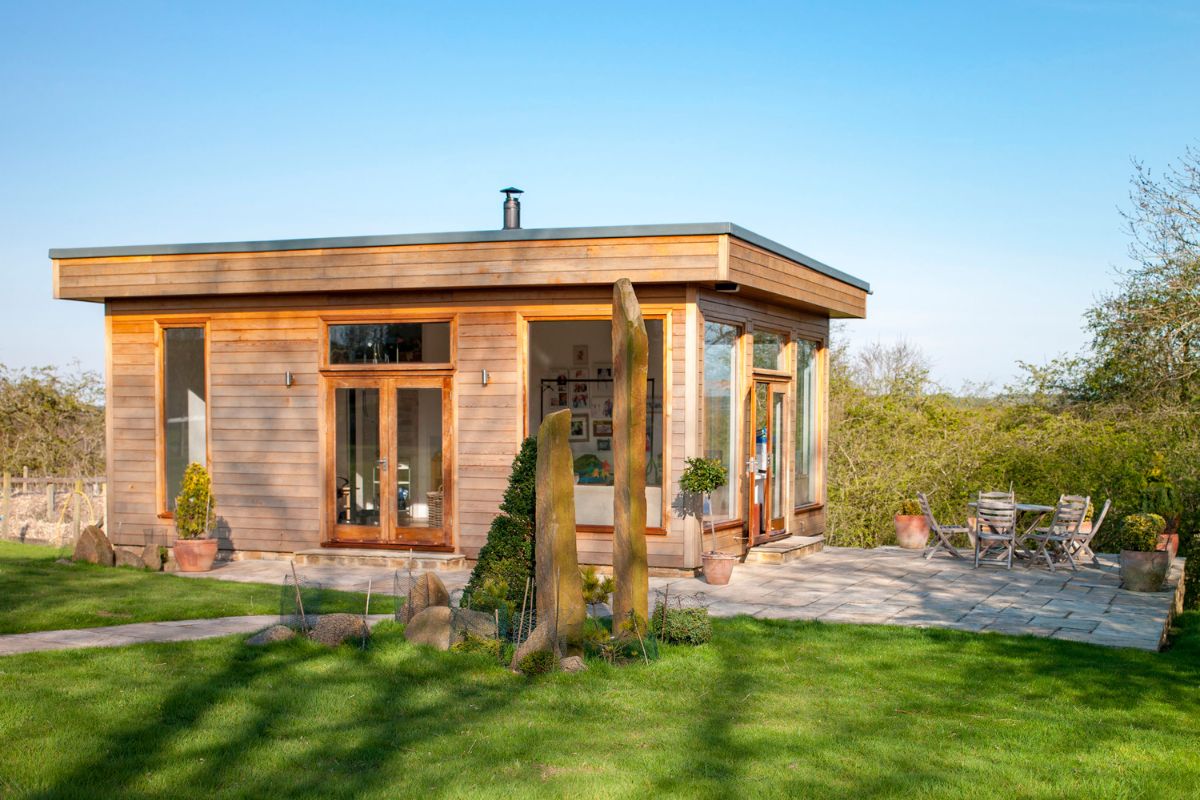Setting up a garden office is a fantastic way to create a dedicated workspace at home that’s away from the distractions of the main house. It also definitely cuts that commute down.
However, a question we get a lot is ‘how much will a garden office cost to run?’
Running a garden office is all about energy use. The answer to how much it will cost to run depends on various set up and heating factors. In our experience, on-going expenses are generally very manageable and less than £50 a month.
In this article, we’ll break down where the typical running costs come from and give you practical examples to make it easier to relate to your garden room.
How much do garden offices cost to run?
The monthly running cost of a garden office will depend on your usage patterns and choices in heating, lighting and appliances.
The running cost on your energy bill is likely to range between £10-50 a month for an insulated garden office.
| Usage level | Monthly cost | Typical setup |
|---|---|---|
| Not a lot | £10-£20 | Occasional use, LED lighting, minimal heating, limited appliance use |
| Moderate | £20-£40 | Fairly regular use, 2-3 hours heating/day, standard office setup |
| Most days | £50+ | Full-time use, extended heating, multiple appliances |
For further information on managing costs and choosing energy-efficient options, check out our garden room cost guide.
Key Factors Influencing Running Costs
Running costs for a garden office depend on several key factors. Each of these influences energy use in different ways. Let’s take a look at these before seeing how much they could be adding on to your energy bill.

Heating
This is usually the largest ongoing expense in a garden office. The type of heating system you choose – whether electric radiators, infrared panels or underfloor heating – will significantly impact costs. Energy-efficient options can lower expenses, but heating is often the most variable cost depending on use and seasonal weather.
Electrical appliances
Essential office equipment like laptops, printers and additional comforts like coffee makers don’t use much energy but can accumulate up over time. The type of appliances, their energy efficiency and their frequency of use play a role in monthly electricity costs.
Lighting
Efficient lighting can be an easy win for lowering running costs. Choosing LED lighting, which is much more energy-efficient than traditional incandescent or halogen bulbs, can significantly reduce electricity costs over time.

Insulation quality
Good insulation plays a vital role in keeping running costs low. A well-insulated office reduces the need for prolonged heating, keeping warmth in during winter and minimising cooling needs in the summer. Have a read of the benefits of an insulated garden office.
Energy-efficient fixtures
From smart thermostats to power strips that minimise standby power consumption, energy-efficient fixtures and fittings can help you control costs. Small adjustments like using low-energy light bulbs, installing draft-sealing door and window strips, and selecting energy-efficient heating systems can all contribute to cost savings. Check out our post on how energy efficient are garden rooms for more info.
How much does heating cost in a garden office?

Heating accounts for a significant portion of running costs, particularly in the cooler months. To give you more of an idea, here’s a breakdown of some standard heating options with costs.
Electric Radiators
Electric radiators are highly efficient and provide immediate warmth, making them ideal for garden offices. With a 500W electric radiator, you can control usage for optimal savings. Costs might look like this:
- 1 hour per day – Consumes 0.5kWh, costing about 12p.
- 3 hours per day – 1.5kWh, costing around 37p.
- 5 hours per day – 2.5kWh, costing approximately 61p.
Electric radiators work well for short bursts of heating, and some come with thermostats and timers for better energy control. These can even be paired with apps on smartphones.
As garden offices tend to be on the smaller side, they’re easy to warm up. An insulated garden office means you’ll have a reduced need to use an electric radiator for long periods. Take a look at this post on garden room sizes.
Pros: Simple to install, quick heating, efficient for regular office use.
Cons: Costs can add up if used continuously throughout the day.
For more information, visit our Garden Room Heating Guide.
Infrared Heating Panels

Infrared panels heat objects rather than the air, providing direct warmth that is perfect for working close by. For a large garden office, you might need 1 or 2 infrared panels.
For the calculations below, we’ve assumed 600W of infrared panels but you could get by with less than this.
- 1 hour per day – Uses 600W, costing around 15p.
- 3 hours per day – 1.8kWh, costing around 44p.
- 5 hours per day – 3kWh, costing approximately 73p.
Pros: Efficient, good for zonal heating in smaller spaces.
Cons: Slightly higher initial cost but lower ongoing expenses with shorter usage periods.
Underfloor Heating
Underfloor heating offers even, consistent warmth across the entire room. A typical setup in a 9m² garden office (3m x 3m) requires around 150W per square metre.
- 1 hour per day – Uses 1.35kWh, costing around 33p.
- 3 hours per day – 4.05kWh, costing around £1.
- 5 hours per day – 6.75kWh, costing around £1.66.
Underfloor heating provides a cosy, even heat and is a comfortable option for all-day use but comes with higher installation costs and running costs as you’ll be using more energy compared to the electric radiator or infrared panel option.
Pros: Quiet, evenly distributed warmth, works well for all-day heating.
Cons: Higher installation cost and higher energy demands.
Oil-Filled Radiators
Oil-filled radiators offer gentle, long-lasting warmth. You don’t feel an immediate blast of warmth with an oil-filled radiator as you do with an electric radiator or convection heater, but they can be useful.
Oil-filled radiators tend to have much higher energy demands, at around 1500W.
- 1 hour per day – Uses 1.5kWh, costing around 37p.
- 3 hours per day – 4.5kWh, costing around £1.10.
- 5 hours per day – 7.5kWh, costing around £1.84.
Pros: Retains heat, ideal for a steady warm-up throughout the day.
Cons: Higher electricity usage, best for sporadic use.

Running Costs for Appliances
Ok, we’ve looked at heating. What about appliance use? How much do these add to the running costs of a garden office?
Appliances contribute to ongoing costs, but most items have low wattage, keeping expenses very manageable.
- Laptop (50W) – For 4 and 8 hours of daily use, this costs approximately 4.9p and 9.8p, respectively. You’ll want to make sure your laptop is connected to WiFi in your garden office.
- Printer (30W on standby, 100W when printing) – Typical office printers don’t consume much power, costing around 2-5p per day for moderate use.
- Coffee maker (1,200W for 5 mins) – Each use costs around 2.5p, making it negligible.
Lighting Costs

LED lighting is ideal for a garden office, using minimal power while providing bright, energy-efficient lighting.
- LED bulb (10W) – Running for 4 hours per day costs around 1p, while 8 hours costs about 2p.
- Incandescent bulb (60W) – This would cost around 6p for 4 hours or 12p for 8 hours daily.
Maximising natural light through well-placed windows or skylights can also reduce lighting costs. See our uses for a garden room post for more ideas on creating a bright, energy-efficient workspace.
Can solar panels be integrated to reduce running costs?
Yes, solar panels can be used on the roof of your garden room to generate your own renewable energy and reduce running costs.
For most garden offices, a couple of solar panels is likely to be enough.
For example, adding 2 x 400W solar panels can generate around 2.4kWh per day on sunny days, potentially saving around £17 monthly – this could be enough energy to run most garden offices making them essentially off-grid.

Cost-saving tips for your garden office
Here are a few of our favourite garden office cost saving tips.
- Smart heating – Install a programmable thermostat to automate heating schedules. Bluetooth or Wifi controlled heating can be managed remotely.
- Insulation – Include roof, wall and floor insulation
- Draft prevention – Add thermal blinds or curtains to windows
- Lighting efficiency – Position your desk to maximise natural light and use LED bulbs exclusively
- Energy efficient appliances – Use eco-mode on appliances to reduce the energy needed to run them
- Double glazing – Install double glazed windows and doors, or triple glazed if you have the budget
Ready to Create Your Energy-Efficient Garden Office?
As you can see, a garden office doesn’t cost much to run when you implement good energy saving measures – around £10-50 a month. They’re also much cheaper to build than an extension, but just as good!
So, if you’re looking to create an energy-efficient garden office that’s kind to both the environment and your wallet, we can help you out.
With a Lux Garden Room we offer superior insulation, an energy-efficient design, expert guidance and a future-proof construction. Our aim is to combine quality with sustainability.
If you’re interested to learn more, take a look at our garden room gallery and check out our designs and prices.
You can get in touch with us today for a free, no obligation quote.
FAQs
1. How much does it cost to run a garden office per month?
Depending on usage, monthly costs can range from £10 to £50 or more. This mainly comes from heating and appliances.
2. What is the most energy-efficient way to heat a garden office?
Electric radiators and infrared panels offer efficient heating, particularly when combined with good insulation. For more, read our garden room heating guide.
3. Do I need planning permission to install a garden office?
Usually, planning permission isn’t required, though larger structures may need approval. Check our planning permission guide for more details.
4. Can I use solar panels to power my garden office?
Yes, solar panels can offset energy costs. Two 400W panels can generate up to 2.4kWh per day, potentially saving around £17 per month.
5. How does insulation impact running costs?
Good insulation significantly reduces heating needs, making a garden office cheaper to run. Learn more in insulated vs non-insulated garden rooms.

